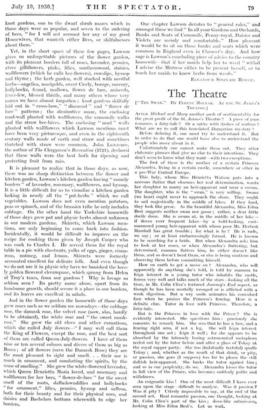The Country Housewife's Garden
YORKSHIRE housewives have ever been famed as much for their love of gardens as for their skill in housekeeping. It is not surprising, therefore, that the first book in our language, written especially for women gardeners, was written by a Yorkshireman and his slender little volume, The Country Housewife's Garden (1618), is the only book which gives us a detailed picture, or rather series of pictures, of the small, homely north country garden of three hundred years ago. It is a curious fact that, although the garden was the special province of the housewife, yet during the first three centuries of our printed garden literature only three books were written for women gardeners. William Law- son's was the only one printed during the seventeenth century ; a hundred years later Charles Evelyn published his Ladies Recreation (1716), and after the lapse of another hundred years Mrs. Loudon's Gardening for Ladies inaugurated the flood of modern literature on this subject. The Country Housewife's Garden was usually issued with Lawson's other classic, A New Orchard and Garden, but The Country Housewife's Garden was published separately at least three times and in this form is an excessively rare book. It is a little book only twenty-six pages long, five of them being devoted to plans for
knot gardens, one to the dwarf shrub mazes which in those days were so popular, and seven to the ordering of bees, " for I will not account her any of my good Housewives, that wanteth either Bees, or skilfulnesses about them."
Yet, in the short space of these few pages, Lawson gives us unforgettable pictures of the flower garden, with its pleasant borders full of roses, lavender, peonies, clove gilliflowers, pinks, lilies, southernwood, daisies, wallflowers (which he calls bee-flowers), cowslips, hyssop and thyme ; the herb garden, well stocked with needful herbs—angelica, marigolds, sweet Cicely, borage, succory, hollyhocks, fennel, mallows, flower de luce, aniseeds, fever-few, blessed thistle, and many others whose very names we have almost forgotten ; knot gardens skilfully laid out in " cross-bow," " diamond " and " flower de Ince " patterns ; the diminutive maze, the enclosing mud-wall planted with wallflowers, the camomile walks and the straw bee-hives. The enclosing " mud " walls planted with wallflowers which Lawson mentions must have been very picturesque, and even in the eighteenth century walls made of earth and straw and sometimes thatched with straw were common. John Lawrence, the author of The Clergyman's Recreation (1721), declared that these Walls were the best both for ripening and protecting fruit from rain.
It is pleasant to realize that in those days, as now, there was no sharp distinction between the flower and kitchen garden, Lawson's kitchen garden having " comely borders " of lavender, rosemary, wallflowers, and hyssop. It is a little difficult for us to visualize a kitchen garden lacking in nearly all the " pot-herbs " which we call vegetables. Lawson does not even mention potatoes, peas or spinach, and of the brassies tribe he only includes cabbage. On the other hand the Yorkshire housewife of those days grew pot and physic herbs almost unknown in our modern gardens. Skirrets, which Laws6n men- tions, are only beginning to conic back into fashion. Incidentally, it would be difficult to improve on the recipe for cooking them given by Joseph Cooper who was cook to Charles I. He served them for the royal table in a pie with chestnuts, yolks of eggs, ginger, cinna- mon, nutmeg, and lemon. Skirrets were formerly accounted excellent for delicate folk. And even though we do not use it in physic why have we banished the love- ly golden flowered elecampane, which sprang from Helen of Troy's tears, from our gardens ? Why is lovage so seldom seen ? Its pretty name alone, apart from its handsome growth, should secure it a place in our borders, and its leaves are excellent in salads.
And in the flower garden the housewife of those days grew roses such as we seldom see nowadays —the cabbage rose, the damask rose, the velvet rose (now, alas; hardly to be obtained), the white rose and " the sweet musk- rose." She grew the old clove and other carnations, which she called July flowers—" I may well call them the King of Flowers, except the rose, and the best sort of them are called Queen-July-flowers. I have of them nine or ten several colours and divers of them as big as Roses ; of all flowers (save the Damask Rose) they arc the most pleasant to sight and smell. . . their use is much in ornament, and comforting the spirits, by the sense of smelling." She grew the white-flowered lavender, which Queen Henrietta Maria loved, and rosemary and wallflowers for her bees, " flower-de-luee " for the sweet smell of the roots, daffadowndillies and hollyhocks " for ornament," lilies, peonies, hyssop and saffron, both for their beauty and for their physical uses, and daisies and Bachelors buttons wherewith to edge her borders.
One chapter Lawson devotes to " general rules," and amongst these we find " In all your Gardens and Orchards, Banks and Seats of Camomile, Penny-royal, Daisies and Violets arc seemly and comfortable." Ilow pleasant it would be to sit oil those banks and seats which were common in England even in Chaucer's day. And how sage is Lawson's concluding piece of advice to the country housewife—that if her maids help her to weed " withal I advise the Mistress either to be present herself, or to teach her maids to know herbs from weeds."
ELEANOUR SINCLAIR ROHDE.

















































 Previous page
Previous page